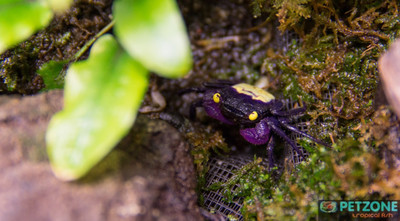Purple Vampire Crab
Posted by Max Gandara on on 8th Jun 2025
Purple Vampire Crab: The Mysterious Jewel of the Terrarium
If you’re into unique, eye-catching invertebrates with a flair for the dramatic, the Purple Vampire Crab may just be the perfect addition to your collection. With its glowing yellow eyes, deep purple body, and almost mythical presence, this small crab is quickly becoming a favorite among paludarium and terrarium hobbyists.
Origins and Habitat
Purple Vampire Crabs are native to Southeast Asia, particularly regions of Java and surrounding Indonesian islands. These crabs are semi-terrestrial, meaning they split their time between land and water, usually favoring humid, tropical environments near freshwater streams or riverbanks.
Despite their sinister-sounding name, they’re not dangerous — to people, anyway. The name “vampire” likely comes from their glowing yellow eyes and somewhat secretive nocturnal behavior.
Appearance: A Living Work of Art
What makes this species so mesmerizing is its bold, vibrant coloration:
-
Carapace: Rich purple to violet hues
-
Legs: Often accented with electric orange or blue
-
Eyes: Piercing yellow that almost seem to glow
-
Size: Up to 1.5 inches (3.8 cm) across the carapace
These crabs look like something out of a fantasy novel, and their small size only adds to their charm.
Ideal Enclosure Setup
Since they're semi-terrestrial, a proper paludarium setup (land + water) is ideal.
Minimum Tank Size:
-
10 gallons for a small colony (3–5 crabs)
-
Provide more space to prevent territorial disputes
Environmental Requirements:
-
Temperature: 75–82°F (24–28°C)
-
Humidity: 75% or higher (misting daily helps)
-
Substrate: Moist coco fiber or sphagnum moss for burrowing
-
Water: Shallow, dechlorinated freshwater pool; use a sponge filter if needed
-
Hiding Spots: Essential — coconut shells, driftwood, rocks, or PVC tunnels
Lighting:
-
Low to moderate. A 12-hour day/night cycle supports healthy behavior and molting.
Important Tip:
Purple Vampire Crabs are escape artists. A tight-fitting lid is a must!
Social Behavior and Temperament
While not aggressive toward humans, they can be territorial, especially males. It’s best to maintain a 1 male : 2+ females ratio and provide plenty of hides.
-
Mostly active at night (nocturnal)
-
Fascinating to observe during feeding or exploring
-
May scavenge or hunt small invertebrates
They can cohabitate peacefully in groups if they have space and proper environment.
Diet and Feeding
Purple Vampire Crabs are omnivores and opportunistic feeders. A balanced diet supports vibrant coloration and health.
What to Feed:
-
Staple: High-quality crab pellets or shrimp pellets
-
Protein: Bloodworms, brine shrimp, small insects
-
Plant Matter: Leaf litter, algae wafers, blanched vegetables (zucchini, spinach)
-
Occasional Treats: Fruits like banana or mango (in very small amounts)
Feed them 3–4 times per week and remove uneaten food promptly to prevent mold or water quality issues.
Breeding in Captivity
Breeding Purple Vampire Crabs is possible and increasingly successful in home setups:
-
Females carry fertilized eggs on their underside for about 30 days
-
Tiny crablets emerge fully formed (no larval stage)
-
Isolate babies to prevent predation
-
Provide micro-food like infusoria or powdered invertebrate foods
If you’re aiming to breed them, stable conditions and low stress are crucial.
Health and Maintenance
These crabs are relatively hardy, but sensitive to poor water and air quality.
Common Issues:
-
Failed molts: Often due to low humidity or lack of calcium
-
Shell erosion: From poor diet or water conditions
-
Inactivity: May indicate stress or illness
Tips:
-
Clean water daily or use filtration
-
Maintain high humidity
-
Provide calcium sources (cuttlebone, crushed eggshells)
Final Thoughts
The Purple Vampire Crab is a beautiful and low-maintenance creature that offers a unique twist to terrarium life. While they may not be ideal for handling or a beginner’s first pet, with proper care and a thoughtful environment, they thrive and become one of the most fascinating critters to observe.
From their otherworldly appearance to their intriguing behaviors, these tiny crabs live up to their mystical name — a perfect blend of mystery and majesty.

